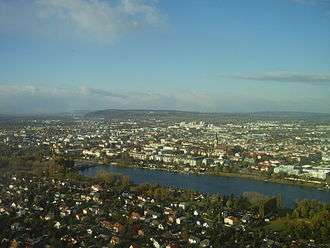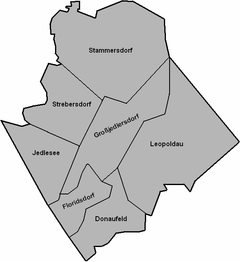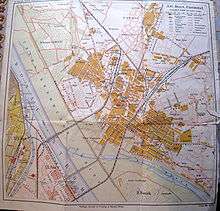Floridsdorf
| Floridsdorf | ||
|---|---|---|
| 21st District of Vienna | ||
| ||
 Location of the district within Vienna | ||
| Country | Austria | |
| City | Vienna | |
| Government | ||
| • District Director | Heinz Lehner (SPÖ) | |
| • First Deputy | Gerhard Spitzer (SPÖ) | |
| • Second Deputy | Kurt Mörz (FPÖ) | |
| • Representation (60 Members) |
SPÖ 28, FPÖ 19, ÖVP 6, Green 5, WIFF 2 | |
| Area | ||
| • Total | 44.46 km2 (17.17 sq mi) | |
| Population (2016-01-01)[1] | ||
| • Total | 155,998 | |
| • Density | 3,500/km2 (9,100/sq mi) | |
| Postal code | A-1210 | |
| Address of District Office |
Am Spitz 1 A-1211 Wien | |
| Website | www.wien.gv.at/bezirke/floridsdorf/ | |
Floridsdorf (German pronunciation: [ˈflɔːʀɪʦˌdɔʁf]) is the 21st district of Vienna, Austria (German: 21. Bezirk, Floridsdorf). Floridsdorf is located in the northern part of Vienna.
Geography

Population centers
The District Office and the centre of Floridsdorf are located round Am Spitz, at the junction of Prager Straße (Prague Street) and Brünner Straße (Brno Street).
Parts of Floridsdorf were formerly villages. For example, there are Stammersdorf, Strebersdorf and Leopoldau. Because of this, Floridsdorf is mostly a very rural district, with many taverns selling homegrown wine (Heurige).
Hills and waters
In the north of Floridsdorf, the area is dominated by the southern foothills of the Bisamberg hill, as the terrain of the municipal district. While the summit of Bisamberg, 358 metres (1,175 ft), is already in Lower Austria, it is the Summit Falkenberg, 320 metres (1,050 ft), which is the highest point in Floridsdorf.
The Danube forms the southwestern border district. A part of the New Danube and a section of the Danube Island are in Floridsdorf, while the water area immediately beyond the Danube island is in the Döbling district area. The Vienna Danube bridges to Floridsdorfer area (ranked in the direction of flow of the Danube) are: the Bridge Jedleseer, the North Bridge, the North Bridge, the Bridge Floridsdorfer, the North Bridge, the U6-Danube Bridge and Brigittenauer Bridge. In Floridsdorf is also the northern part of the Old Danube. In 1992, the Marchfeld channel was put into operation, which crosses the district area.
District parts

The Floridsdorf district consists of seven formerly independent communities in their entirety: Floridsdorf (community), Donaufeld, Großjedlersdorf, Jedlesee, Leopoldau, Stammersdorf, and Strebersdorf. It also contains portions of two others.
The eponymous district part Floridsdorf is also the smallest in area. The largest part is Stammersdorf, in the north of the district. Stammersdorf borders Strebersdorf and Großjedlersdorf, consisting of the two Katastralgemeinden Großjedlersdorf I and II. To the east, on the border of the 22nd district, are Leopoldau and Donaufeld. Jedlesee in the west is composed of Jedlesee and Schwarze Lackenau. In addition to those full sub-districts, Floridsdorf also contains small parts of Kagran and Kaisermühlen, the largest parts of which lie in the district of Donaustadt.
The district is also broken down into 28 census districts. Although their names are identical or nearly identical to the corresponding Katastralgemeinden, the census districts of Donaufeld, Gross Jedlersdorf, Old Jedlesee, New Jedlesee, Leopoldau, Schwarzlackenau, Stammersdorf and Strebersdorf have distinct borders. Settlements and parcels of land have given their names to the census districts of Hirschfeld, Nordrandsiedlung, Großfeldsiedlung, Schottenfeld, Siemensstrasse, Jochberg, Donaufelder Gartnergebiet, Mühlschüttel, Bruckhaufen and Industriegelande Bahndreieck. The district of Autokader takes its name from the largest auto plant of the Habsburg monarchy (Austro-Fiat); Gaswerk Leopoldau refers to the city gas works, opened in 1911. The remaining Floridsdorfer census districts are named for streets: Stammersdorf-Brünner Straße, Leopoldauer Straße-Siemensstraße, Strebersdorf-Pragerstraße, Koloniestraße, Shuttleworthstraße, Floridsdorf-Brünnerstraße, Floridsdorf-Am Spitz und Donaufeld-Leopoldauer Straße.
History



The first settlements, in this area, were already there in the New Stone Age (about 4000 to 2000 BC). Stone hatchets and pot remains found, from that time, indicate that there were hunters who first settled in this area.
In the area of Leopoldau, weapons were made of bronze, and jewelry found suggests a settlement. Several items are in the District Museum.
Around 500 BC, Celts came in the territory of present-day Floridsdorf, but lost when the Romans came back to their influence. It has long been the territory of no-man's-land, a buffer zone between the Romans and Germans, and there were also repeated battles between the two peoples.
After the end of Roman rule, it drew Longobards, Avars and Slavs in the area. The Avars were later defeated by Carlomagno, turning Bayern into the country from the Magyars to be distributed. Around 1000 AD, the Babenberg was in this area; again in 1014 and it was the first written mention of the district Floridsdorfer Jedlesee, then called Outcinesse (Sea of Uz).
For a long time, the Danube could be crossed only by ferry. In the year 1500, the first bridge was built. At the site of today's Floridsdorfer Haupstrasse, near the water park, the first wooden bridge (Tabor Bridge) was built. Another bridge, the Kuhbrückl, crossed a small arm of the Danube. At the fork of the main road to Bohemia and Moravia, the new settlement of Floridsdorf came to be.
Floridsdorf was first called "Am Spitz" and was later assigned to the Klosterneuburg Abbey. In 1786 Floridus Leeb, abbot of the monastery, transferred 26 properties to settler families. Through industrialization, Floridsdorf, which originally was heavily dominated by agriculture, changed in a short time, so that on 8 May 1894 with the villages Donaufeld, Jedlesee and New Jedlersdorf for major Floridsdorf community was united. The Dampftramway and the Northwest Railway have also contributed to industrialization. Today, a commemorative panel in the Floridsdorf station, proclaims that on 23 November 1837 with the opening of the first section of the Emperor Ferdinand-Nordbahn between Floridsdorf and Deutsch-Wagram, the railway era began in Austria.
From the middle of the 19th century, there were also efforts to make Vienna reichsunmittelbar, separating it from the crown land of Austria at the Enns. In this case, Floridsdorf was seen as the future capital of Lower Austria.
In 1904, Floridsdorf had localities Jedlesee, Großjedlersdorf, Donaufeld, Leopoldau, Kagran, Hirschstetten, Stadlau and Aspern. Then in 1910, also incorporated was Strebersdorf (Vienna) into Vienna. Through the establishment of the new district Donaustadt in 1938, Floridsdorf lost Kagran, Stadlau, Hirschstetten, Aspern and Lobau. During the Oil Campaign of World War II, the Floridsdorf oil refinery and oil sidings were bombed by the Allies, in addition to a part of the southern Heinkel aviation firm's Heinkel-Süd military aircraft production facilities. In 1954, the borders of Lower Austria and Donaustadt were re-drawn and Stammersdorf incorporated.
As a consequence, there were four changes to the demarcation of the border district of Donaustadt. In 1964, the district border in the eastern Aderklaa road [2] and in the area of the pile in Bruck Donaufeld [3] slightly delayed.
In 1995, a marginal adjustment in the field and Zehdengasse Eipeldauerstraße.[4] over long distances changed the course of the Danube border town in 2002 and in the areas of Oscar-Grissemann Street, Josef Baumann Street, Old Danube, and Drygalskiweg Wagramer street.[5] Affected by these boundary changes were mainly traffic, and in Floridsdorf, the big sports in the street Eipeldauer was also added. In return, the District lost a larger share of the water area of the Old Danube to the Donaustadt District.
Population
 |
Population development
Today's district includes the area of Floridsdorf from 1869, which had, with its villages, only 12,022 inhabitants. With the city limits located near Vienna, the population increased rapidly and showed, up to the First World War, very high growth rates. In 1910, Floridsdorf already had 62,154 inhabitants, and its population since 1869 had more than quintupled. Since Floridsdorf after the First World War, had comparatively low population density, compared to other districts, the population rose more gradually. Apart from a brief decline in population around the Second World War, the district population has grown continuously, with the growth rates from the 1990s declined significantly. At the beginning of 2007, there were 137,186 people in Floridsdorf: the 21st District hosts the third largest population. With 3,086 inhabitants per km², Floridsdorf ranks, in terms of population density, only in the bottom quarter of the more than 20 Vienna municipal districts.
Population structure
In Floridsdorf lived, during 2005, significantly more children, but also a slightly higher number of people over 60 years than the average of Vienna. The number of children under 15 years was 16.2% higher than for the total area of Vienna (14.6%). The proportion of the population from 15 to 59 years was 61.4% (Vienna: 63.4%) well below the average, while the population Floridsdorfer especially in the age group of people 20 to 34 years of deficits in it. The proportion of people aged 60 years or more was 22.5% (Vienna: 22.0%) slightly above the average of Vienna. The gender distribution was in the district area in 2001 was 47.3% men and 52.7% women, the number of married people had a share of 43.0% compared to 41.2% above the average of Vienna.[6][7]
Origin and language
The proportion of foreign district residents in 2006 was 11% (Vienna city-wide: 19.1%).[8] This was the fourth rank of a district of Vienna. As in the entire state, the foreign population growth in 2001, the proportion was 7.8%. The highest proportion of foreign residents in 2005 represented about 2.3% share of the district population as nationals from Serbia and Montenegro. Another 1.2% were Turkish, 0.9% Polish and 0.6% German citizens. In 2001, a total of 15.4% of the district population was born in Austria. Nearly 3.0% expressed as a language Serbian, 2.3% Turkish and 1.1% Croatian. [6][9]
Religion
Floridsdorf has, with 53.9%, one of the highest populations of people with Roman Catholic faith in Vienna (Vienna city-wide: 49.2%). There are 16 districts with Roman Catholic parishes, the City Deanery 21 form. By contrast, the proportion of people with Islamic faith is 4.9% and the Orthodox believers with strong 3.0% below the average. The proportion of Protestant residents stood at 4.4% in the overall context of Vienna. 28.9% of the district population 2001 are not included religious community, but this is the highest value of a municipality of Vienna was. Further 4.9% of the population had no religion or another confession given.[6]
Politics
| District Directors from 1945 | |
|---|---|
| Franz Koch (SPÖ) | 1945–1946 |
| Franz Jonas (SPÖ) | 1946–1948 |
| Ernst Theumer (SPÖ) | 1948–1959 |
| Rudolf Hitzinger (SPÖ) | 1959–1964 |
| Otmar Emerling (SPÖ) | 1964–1980 |
| Kurt Landsmann (SPÖ) | 1980–1994 |
| Heinz Lehner (SPÖ) | 1994– |
Crest (coat of arms)
The coat of arms of Floridsdorf is six-part. On the shield, the coat of arms of the previously independent municipalities Floridsdorf, Jedlersdorf large, Jedlesee, Leopoldau, Stammer village, Strebersdorf merged.

The six parts of the coats of arms are as follows:
- Floridsdorf: The coat of arms (center panel) shows a vase with three red flowers on green stalks between eight green leaves on a silver background.
- Leopoldau: The upper-left coat of arms is a brown clad right arm, five golden ears of grain, on a blue background.
- Stammersdorf: The top-right coat of arms shows a deciduous tree and three coniferous trees on a green lawn, silver background.
- Jedlesee: The bottom-left coat of arms is the grace-crowned image of the Virgin Mary Loretto, dressed in gold, laced with pearls and precious stones, shown with the child Jesus and surrounded by the red letters M and L, for "Maria Loretto" on a silver background.
- Strebersdorf: The bottom-right coat of arms shows a red-roofed guard tower with two round window openings and two red flags with a golden knob on the ridge in a green field with a blue background.
- Gross Jedlersdorf: The bottom-middle coat of arms shows two crossed sacks/bags on a red background.
Notable residents
- Hannes Androsch
- Marko Arnautovic
- Franz Jonas
- Andy Borg
- Karl Markovics
- Karl Nieschlag
- Hermann Nitsch
- Peter Pacult
- Peter Resetarits
- Erika Pluhar
- Toni Strobl
- Louis Black
Important buildings
- Many suburban settlements with gardens
- Numerous large settlements
- Großfeldsiedlung
- Nordrandsiedlung
- Siedlung Jedlesee
- Bruckhaufen
- Neu-Stammersdorf
- Schlingerhof
- Karl-Seitz-Hof
- Rosa-Weber-Hof
- Paul-Speiser-Hof
- Franz-Koch-Hof (ugs. Klein-Manhattan)
- Schools and other educational institutions
- Religious School of Education campus in Vienna Vienna - Strebersdorf (including practice and practice Volksschule Hauptschule - Cooperative Middle School)
- Vocational school for automotive technology, plumbing and Karosseure
- Special school for severely handicapped children
- Higher College for Tourism
- Higher College for Economic Occupations
- School of Animal Care Fund for the Promotion of Animal Training
- School brothers Strebersdorf
- Federal High School and Franklin Street Bundesrealgymnasium 21
- Federal and Federal School Gymnasium Franklin Straße 26
- Federal and Federal School Gymnasium Ödenburgerstraße
- Federal and Federal School Gymnasium "Bertha von Suttner", training ship
- Federal and Federal School Gymnasium "Ella Lingens Gymnasium" (formerly: Gerasdorf Street)
- University of Vienna - Business Center (BWZ)
- University of Veterinary Medicine Vienna
- Volkshochschule Floridsdorf
- Churches
- Church of the Order of Friars School Strebersdorf (Jean Baptiste de La Salle)
- Pfarrkirche Queen Mary (Strebersdorf)
- Donaufeld parish church
- Floridsdorfer St. Jakob
- Großjedlersdorfer Parish Church of St. Charles Borromeo (small pilgrimage church Maria Taferl)
- San Marco Polo Square
- Pastoral station of St. Michael
- Maria Loretto Church (Jedlesee)
- Pfarrkirche Gartenstadt
- Social Floridsdorf Medical Center - Hospital and Geriatric Center
Arts and Culture
Sights
- Beethoven Memorial
- Beethovenweg
- Pfarrkirche Donaufeld (The bulky neo-early brick is the third highest church in Vienna and was, before the incorporation of Floridsdorf, planned to be the "Dom Niederösterreichs".)
- The Vienna Danube Island
- The Old Danube
Museum
The District Museum was founded in 1960 in Floridsdorf Mautner Schlössl (Prague Street) building. The district museum is devoted mainly to the emergence of the landscape left the Danube, the beginning of steam navigation, railway history and the history of the old places. The "Museum of Beschirrung and Besattelung, orthopedic and veterinary Hufbeschlag collects bone specimens, saddles, horse and beef dishes and the development of Hufbeschlags by the Romans to the present dar. In addition, the museum on the single ostrich saddle in the world. The "1 Fisheries Museum Vienna offers its visitors information about fishing in the changing times. The exhibition features rare specimens of native fish, aquariums, ancient writings and exhibits, fishing gear and fish-eating "animals. In Jedlesee, in the former estate of Countess Anna-Maria Erdody, a memorial to Ludwig van Beethoven was established.
Choirs
The choir-group Harmony (exact name: Floridsdorfer Chorvereinigung "Harmony 1865"; founded: 1865) is a mixed choir, consisting of an average of 40 members. It meets regularly to the public, for example during the Festival-week or the Christmas season, always with the appropriate program for the season. From time to time, the choir travels, to Kraków, most recently, Rome or in Tuscany, and gives concerts or makes various worship musically.
Twin Cities
Sports clubs
- Sports Union Donaufeld
- Leopoldau Sports Union
See also
- Lokomotivfabrik Floridsdorf - locomotive works in Floridsdorf
Notes
- ↑ Statistik Austria
- ↑ Law of 31 January 1964 on a slight change in the boundar between 21 and 22 District (Vienna LGBl 6 / 1964) issued on 9 April 1964
- ↑ Law, 31 July 1964 over a minor adjustment to the boundary between 21 and 22 District (Vienna LGBl 23/1964) issued on 21 December 1964
- ↑ Act to amend the boundary between 21 and 22 District (Vienna LGBl 49/1995) issued on 23 June 1995
- ↑ Act on an amendment the boundary between 21 and 22 District (Vienna LGBl 39/2002) issued on 18 September 2002.
- 1 2 3 Statistics Austria (2001 census)
- ↑ MA 5 resident population by age groups and districts 2005
- ↑ population update after district 2004 by 2006 (based on Census 2001), wien.gv.at
- ↑ MA 5 resident population by nationality and districts 2001-2005
References
- [Parts of this article were translated from German Wikipedia.]
- "Wien - 21. Bezirk/Floridsdorf", Wien.gv.at, 2008, webpage (15 subpages): Wien.gv.at-floridsdorf.
- Felix Czeike: Wiener Bezirkskulturführer: XXI. Floridsdorf ("Vienna District Cultural Leader: XXI. Floridsdorf"). Jugend and Volk, Vienna 1979, ISBN 3-7141-6221-6.
- Raimund Hinkel, Kurt Landsmann, Robert Vrtala: Floridsdorf von A-Z. Der 21. Bezirk in 1.000 Stichworten ("Floridsdorf from A-Z: the 21st District in 1,000 words"). Brandstätter, Vienna 1997, ISBN 3-85447-724-4.
- Kurt Landsmann: Floridsdorf 1945: das Kriegsende. Ein Beitrag zur Zeitgeschichte ("Floridsdorf 1945: The War's End: A View of Time History"). Brandstätter Verlag, Vienna 1995, ISBN 3-85447-622-1.
- Carola Leitner (Hg.): Floridsdorf: Wiens 21. Bezirk in alten Fotografien ("Floridsdorf: Vienna's 21st District in Old Photographs"). Ueberreuter, Vienna 2006, ISBN 3-8000-7206-8.
- Peter Schubert: Jugendstil & Co: Hausschmuck in Floridsdorf 1880–1930 ("Houses in Floridsdorf 1880–1930"). Mayer, Klosterneuburg 2001, ISBN 3-901025-93-6.
External links
- Districtcommunity Floridsdorf (German)
- Official Website (German)
- District Museum of Floridsdorf (German)
- Official Website of SCN (Shopping Center Nord) (German)
Coordinates: 48°17′00″N 16°24′44″E / 48.28333°N 16.41222°E
| Wikimedia Commons has media related to Floridsdorf. |

